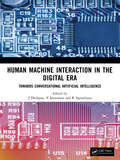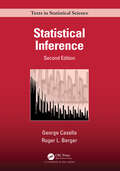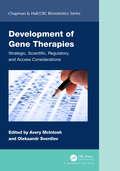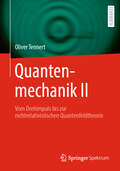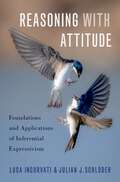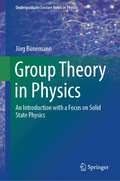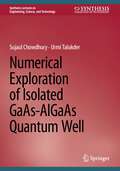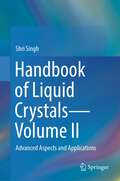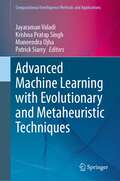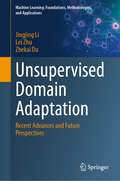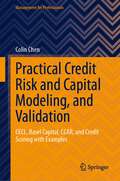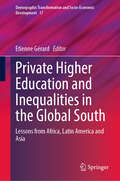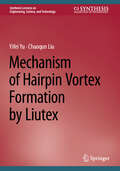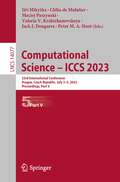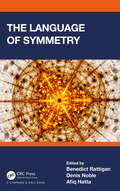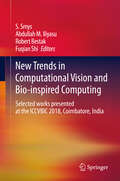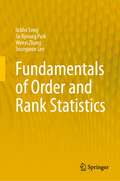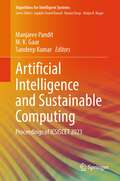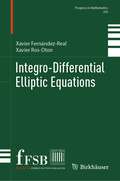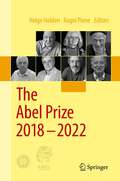- Table View
- List View
Human Machine Interaction in the Digital Era: Towards Conversational Artificial Intelligence
by J. Dhilipan V. Saravanan R. AgusthiyarThe Human Machine Interaction in the Digital Era (ICHMIDE) 2023 conference aims to address the main issues of concern in the design issues with a particular emphasis on the design and development of interfaces for autonomous robots. Its main objective is to provide an international forum for the dissemination and exchange of up-to-date scientific information on research related to integrated human/machine systems at multiple scales, and includes areas such as human/machine interaction, engineering mathematical models, assistive technologies, system modelling, design, testing and validation. The organization of ICHMS is based on the following Track types: Smart Applications for Digital Era, Computational Mathematical and Electronics, Intelligent Systems in Security and Communication Technologies, Technological Interventions using AI and Machine Learning, Applied Science, and IoT Techniques for Industries.
Human Machine Interaction in the Digital Era: Towards Conversational Artificial Intelligence
by J. Dhilipan V. Saravanan R. AgusthiyarThe Human Machine Interaction in the Digital Era (ICHMIDE) 2023 conference aims to address the main issues of concern in the design issues with a particular emphasis on the design and development of interfaces for autonomous robots. Its main objective is to provide an international forum for the dissemination and exchange of up-to-date scientific information on research related to integrated human/machine systems at multiple scales, and includes areas such as human/machine interaction, engineering mathematical models, assistive technologies, system modelling, design, testing and validation. The organization of ICHMS is based on the following Track types: Smart Applications for Digital Era, Computational Mathematical and Electronics, Intelligent Systems in Security and Communication Technologies, Technological Interventions using AI and Machine Learning, Applied Science, and IoT Techniques for Industries.
Statistical Inference (Chapman & Hall/CRC Texts in Statistical Science)
by George Casella Roger BergerThis classic textbook builds theoretical statistics from the first principles of probability theory. Starting from the basics of probability, the authors develop the theory of statistical inference using techniques, definitions, and concepts that are statistical and natural extensions, and consequences, of previous concepts. It covers all topics from a standard inference course including: distributions, random variables, data reduction, point estimation, hypothesis testing, and interval estimation. Features The classic graduate-level textbook on statistical inference Develops elements of statistical theory from first principles of probability Written in a lucid style accessible to anyone with some background in calculus Covers all key topics of a standard course in inference Hundreds of examples throughout to aid understanding Each chapter includes an extensive set of graduated exercises Statistical Inference, Second Edition is primarily aimed at graduate students of statistics, but can be used by advanced undergraduate students majoring in statistics who have a solid mathematics background. It also stresses the more practical uses of statistical theory, being more concerned with understanding basic statistical concepts and deriving reasonable statistical procedures, while less focused on formal optimality considerations.This is a reprint of the second edition originally published by Cengage Learning, Inc. in 2001.
Statistical Inference (Chapman & Hall/CRC Texts in Statistical Science)
by George Casella Roger BergerThis classic textbook builds theoretical statistics from the first principles of probability theory. Starting from the basics of probability, the authors develop the theory of statistical inference using techniques, definitions, and concepts that are statistical and natural extensions, and consequences, of previous concepts. It covers all topics from a standard inference course including: distributions, random variables, data reduction, point estimation, hypothesis testing, and interval estimation. Features The classic graduate-level textbook on statistical inference Develops elements of statistical theory from first principles of probability Written in a lucid style accessible to anyone with some background in calculus Covers all key topics of a standard course in inference Hundreds of examples throughout to aid understanding Each chapter includes an extensive set of graduated exercises Statistical Inference, Second Edition is primarily aimed at graduate students of statistics, but can be used by advanced undergraduate students majoring in statistics who have a solid mathematics background. It also stresses the more practical uses of statistical theory, being more concerned with understanding basic statistical concepts and deriving reasonable statistical procedures, while less focused on formal optimality considerations.This is a reprint of the second edition originally published by Cengage Learning, Inc. in 2001.
Development of Gene Therapies: Strategic, Scientific, Regulatory, and Access Considerations (Chapman & Hall/CRC Biostatistics Series)
by Avery McIntosh Oleksandr SverdlovCell and gene therapies have become the third major drug modality in pharmaceutical medicine of the 21st century after low molecular weight and antibody drugs. The gene therapy (GTx) field is rapidly advancing, and yet there are still fundamental scientific questions that remain to be answered. Development of GTx products poses unique challenges and opportunities for drug developers. However, there is lack of a systematic exposition of the GTx product development and the pivotal role of the biostatistician in this process. Development of Gene Therapies: Strategic, Scientific, and Regulatory, and Access Considerations attempts to summarize the current state-of-the-art strategic, scientific, statistical, and regulatory aspects of GTx development. Intended to provide an exposition to the GTx new product development through peer-reviewed papers written by subject matter experts in this emerging field, this book will be useful for researchers in gene therapy drug development, biostatisticians, regulators, patient advocates, graduate students, and the finance and business development community . Key Features: A collection of papers covering a wide spectrum of topics in gene therapies (GTx), written by leading subject matter experts. An exposition of the core principles of GTx product development, emerging business models, industry standards, best practices, and regulatory pathways. An exposition of statistical and innovative modeling tools for design and analysis of clinical trials of GTx. Insights into commercial models, access hurdles, and health economics of gene therapies. Case studies of successful GTx approvals from core team members that developed the first two FDA-approved AAV gene therapies: Luxturna and Zolgensma. A discussion of potential benefits and hurdles to be overcome for GTx in coming years from a multi-stakeholder perspective.
Development of Gene Therapies: Strategic, Scientific, Regulatory, and Access Considerations (Chapman & Hall/CRC Biostatistics Series)
Cell and gene therapies have become the third major drug modality in pharmaceutical medicine of the 21st century after low molecular weight and antibody drugs. The gene therapy (GTx) field is rapidly advancing, and yet there are still fundamental scientific questions that remain to be answered. Development of GTx products poses unique challenges and opportunities for drug developers. However, there is lack of a systematic exposition of the GTx product development and the pivotal role of the biostatistician in this process. Development of Gene Therapies: Strategic, Scientific, and Regulatory, and Access Considerations attempts to summarize the current state-of-the-art strategic, scientific, statistical, and regulatory aspects of GTx development. Intended to provide an exposition to the GTx new product development through peer-reviewed papers written by subject matter experts in this emerging field, this book will be useful for researchers in gene therapy drug development, biostatisticians, regulators, patient advocates, graduate students, and the finance and business development community . Key Features: A collection of papers covering a wide spectrum of topics in gene therapies (GTx), written by leading subject matter experts. An exposition of the core principles of GTx product development, emerging business models, industry standards, best practices, and regulatory pathways. An exposition of statistical and innovative modeling tools for design and analysis of clinical trials of GTx. Insights into commercial models, access hurdles, and health economics of gene therapies. Case studies of successful GTx approvals from core team members that developed the first two FDA-approved AAV gene therapies: Luxturna and Zolgensma. A discussion of potential benefits and hurdles to be overcome for GTx in coming years from a multi-stakeholder perspective.
Deborah Meaden Talks Money (Talks)
by null Deborah MeadenTHE empowering intro to money and finance that EVERY young person needs right now, from Dragons’ Den investor and entrepreneur DEBORAH MEADEN. Finance made fun? YES, REALLY! Dragons' Den investor and entrepreneur, Deborah Meaden, makes finance exciting, relatable and personal – AT LAST! Money is such a huge part of our lives, so learning how to make it work best for YOU is a crucial skill. Knowledge is power! Whether you want to earn money, save money, set goals, or set up and grow a business, Deborah will be your personal guide, demystifying the world of finance, and sharing the knowledge and insights that have made her one of the UK’s most successful entrepreneurs. Fearful of finance? You are not alone! TALKS MONEY is packed with podcast-style interviews with ordinary young people, as well as top business people and personalities, including STEVEN BARTLETT, JOE LYCETT, GARY NEVILLE and SOPHIE ELLIS-BEXTOR, who reveal the secrets to their success – and the mistakes they’ve made along the way. Create great money habits! With Q&As, quizzes, tips and challenges, TALKS MONEY is the ONLY guide you need to building the skills and confidence you need to manage finances and reduce money worries. The empowering finance book that EVERY young person needs right now. Book 2 in the TALKS series coming in August 2024.
Quantenmechanik II: Vom Drehimpuls bis zur nichtrelativistischen Quantenfeldtheorie
by Oliver TennertIn einer umfassenden Darstellung entwickeln und vertiefen die vier Bände dieses Lehrbuchs das Gebäude der nichtrelativistischen Quantenmechanik, weshalb sie auch bestens als Nachschlagewerk geeignet sind. Der zweite Band behandelt den quantenmechanischen Drehimpuls, sowie Symmetrien in der nichtrelativistischen Quantenmechanik. Anschließend wird das wichtige Anwendungsgebiet der dreidimensionalen Probleme sowohl auf algebraischem Wege als auch mit analytischen Methoden untersucht. Es schließen sich Kapitel zu Teilchen in elektromagnetischen Feldern und zum großen Themenkomplex identischer Teilchen an, welcher nahtlos zur Feldquantisierung weiterführt. Besonderheiten: Auch komplizierte Zusammenhänge werden illustrativ und klar erklärt. Zahlreiche mathematische Einschübe erläutern allgemeine mathematische Zusammenhänge. Besondere Highlights des Buches sind der algebraische Beweis zur Ganzzahligkeit des Bahndrehimpulses, die ausführliche Untersuchung des Zusammenhangs zwischen Clifford-Algebren und Spinoren, sowie ein Linearisierungsansatz für die Schrödinger-Gleichung. Die Mathematik der Eichtheorien bietet eine zusammenhängende Formulierung sehr vieler topologischer Phänomene wie magnetischer Monopole, des Aharonov–Bohm-Effekts oder von Landau-Niveaus. Inhalt 1. Theorie des Drehimpulses I - 2. Symmetrien in der Quantenmechanik I - 3. Dreidimensionale Probleme - 4. Teilchen in elektromagnetischen Feldern - 5. Theorie des Drehimpulses II - 6. Identische Teilchen und nichtrelativistische Quantenfeldtheorie Zielgruppe: Das Buch richtet sich sowohl an Bachelor- als auch an Masterstudierende sowie ihre Lehrenden. Aufgrund seines mehrbändigen Charakters, der breiten Themenvielfalt und Bezügen zu wissenschaftlichen Originalarbeiten allerdings ein Muss für jedes Bücherregal einer in der Physik tätigen Person. Vorkenntnisse: Vorausgesetzt werden Kenntnisse der Theoretischen Mechanik, der Elektrodynamik und der Speziellen Relativitätstheorie, sowie der Analysis, der linearen Algebra und der Funktionentheorie.
Reasoning with Attitude: Foundations and Applications of Inferential Expressivism
by Luca Incurvati Julian J. Schl?derThis is an open access title available under the terms of a CC BY-NC-ND 4.0 license. It is free to read at Oxford Academic and offered as a free PDF download from OUP and selected open access locations. Certain combinations of sounds or signs on paper are meaningful. What makes it the case that, unlike most combinations of sounds or signs, they have meaning? What is this meaning that they have? And what is it to understand this meaning? This book advances new answers to these questions by developing inferential expressivism, a novel approach to the study of meaning which combines elements of the expressivist and inferentialist programs. Expressivists explain the meaning of words in terms of the attitudes that words are used to express; inferentialists explain the meaning of words in terms of the inferences that words are used to draw. Reasoning with Attitude lays out the foundations of inferential expressivism by defending the view that the meaning of an expression is to be explained in terms of the inferences we draw involving the attitudes we express. As the book shows, by joining forces, expressivism and inferentialism can meet their key challenges whilst retaining their distinctive insights and advantages. Notably, inferential expressivism solves the Frege-Geach Problem plaguing expressivism, and addresses the charge that inferentialism has limited applicability. The book demonstrates the fruitfulness of the inferential expressivist approach by applying it to several open questions in semantics from different areas of inquiry, including epistemic operators and conditionals in the philosophy of language, negation and the truth predicate in the philosophy of logic, and normative vocabulary in meta-ethics.
Reasoning with Attitude: Foundations and Applications of Inferential Expressivism
by Luca Incurvati Julian J. Schl?derThis is an open access title available under the terms of a CC BY-NC-ND 4.0 license. It is free to read at Oxford Academic and offered as a free PDF download from OUP and selected open access locations. Certain combinations of sounds or signs on paper are meaningful. What makes it the case that, unlike most combinations of sounds or signs, they have meaning? What is this meaning that they have? And what is it to understand this meaning? This book advances new answers to these questions by developing inferential expressivism, a novel approach to the study of meaning which combines elements of the expressivist and inferentialist programs. Expressivists explain the meaning of words in terms of the attitudes that words are used to express; inferentialists explain the meaning of words in terms of the inferences that words are used to draw. Reasoning with Attitude lays out the foundations of inferential expressivism by defending the view that the meaning of an expression is to be explained in terms of the inferences we draw involving the attitudes we express. As the book shows, by joining forces, expressivism and inferentialism can meet their key challenges whilst retaining their distinctive insights and advantages. Notably, inferential expressivism solves the Frege-Geach Problem plaguing expressivism, and addresses the charge that inferentialism has limited applicability. The book demonstrates the fruitfulness of the inferential expressivist approach by applying it to several open questions in semantics from different areas of inquiry, including epistemic operators and conditionals in the philosophy of language, negation and the truth predicate in the philosophy of logic, and normative vocabulary in meta-ethics.
Group Theory in Physics: An Introduction with a Focus on Solid State Physics (Undergraduate Lecture Notes in Physics)
by Jörg BünemannThis textbook provides a didactic introduction to the topic of group theory in physics, with a special focus on solid state physics issues. The book is useful for students who encounter such problems in their first scientific work (in theory or experiment). In addition to the basic introduction to group theory and representation theory, the book deals with point groups, double point groups, and space groups, which are essential in solid state physics. As an example for systems with space group symmetry, electrons in periodic potentials are discussed. Furthermore, there are chapters on material tensors and the Wigner Eckart theorem for the evaluation of matrix elements. The latter is especially interesting for students dealing with spectroscopic problems. The content is accompanied by a series of exercises and examples. A set of solutions can be found in the appendix.
Numerical Exploration of Isolated GaAs-AlGaAs Quantum Well (Synthesis Lectures on Engineering, Science, and Technology)
by Sujaul Chowdhury Urmi TalukderThis book begins with the eigenvalue equation of energy and presents calculation of the energy spectrum of GaAs-AlGaAs Quantum Well using finite difference method and knowledge of potential energy profile, without using expressions for eigenfunctions, continuity of eigenfunctions, or their spatial derivatives at the two abrupt potential steps. The authors find that the results are almost the same as those obtained by solving numerically using regula falsi method, and transcendental equations that are obeyed by the energy levels, where the transcendental equations are obtained by requiring continuity of eigenfunctions and of their spatial derivatives at the two potential steps. Thus, this book confirms that it is possible to numerically calculate the energy spectrum of Quantum Well by the finite difference method when it is not correct or when it is not possible to use continuity of eigenfunctions and their spatial derivatives at the two abrupt potential steps. The authors also showthat it is possible to use the finite difference method in cases where the potential steps are non-abrupt. The book demonstrates this by calculating the energy spectrum of isolated parabolic Quantum Well of finite depth using finite difference method.
Handbook of Liquid Crystals—Volume II: Advanced Aspects and Applications
by Shri SinghThis expert and self-contained authored handbook provides comprehensive coverage of liquid crystals from the fundamental materials science, physics, and modeling through cutting-edge applications. Written by an author with over 40 years of active experience in this growing field, it offers an unprecedented self-contained treatment of this key research area.Liquid Crystals are a state of matter sharing properties that are usually associated with both solids and liquids. Their study belongs to wider field of soft condensed matter physics, an area growing in importance because of the new physics being discovered and the possibilities of various technological applications being developed. Liquid crystals continue to have a revolutionary technological impact and consistently pose new challenges of basic understanding. While the experimental side of liquid crystal research is very well developed, theoretical understanding has lagged, and this volume fills a gap in the published literature in terms of rigorous treatment of mathematical and computer modeling approaches.Volume II of this handbook deals with advanced aspects of liquid crystals and their applications, covering computer simulations of phase transitions in liquid crystals, liquid crystals of biomolecules, and defect textures in liquid crystals. Overall, this handbook serves as the ultimate scholarly guide for researchers, scientists, and engineers seeking to unlock the full potential of liquid crystals. It offers a comprehensive understanding of these materials and their diverse applications, empowering readers to navigate the complex intricacies of liquid crystal science and technology.
Advanced Machine Learning with Evolutionary and Metaheuristic Techniques (Computational Intelligence Methods and Applications)
by Jayaraman Valadi Krishna Pratap Singh Muneendra Ojha Patrick SiarryThis book delves into practical implementation of evolutionary and metaheuristic algorithms to advance the capacity of machine learning. The readers can gain insight into the capabilities of data-driven evolutionary optimization in materials mechanics, and optimize your learning algorithms for maximum efficiency. Or unlock the strategies behind hyperparameter optimization to enhance your transfer learning algorithms, yielding remarkable outcomes. Or embark on an illuminating journey through evolutionary techniques designed for constructing deep-learning frameworks. The book also introduces an intelligent RPL attack detection system tailored for IoT networks. Explore a promising avenue of optimization by fusing Particle Swarm Optimization with Reinforcement Learning. It uncovers the indispensable role of metaheuristics in supervised machine learning algorithms. Ultimately, this book bridges the realms of evolutionary dynamic optimization andmachine learning, paving the way for pioneering innovations in the field.
Unsupervised Domain Adaptation: Recent Advances and Future Perspectives (Machine Learning: Foundations, Methodologies, and Applications)
by Jingjing Li Lei Zhu Zhekai DuUnsupervised domain adaptation (UDA) is a challenging problem in machine learning where the model is trained on a source domain with labeled data and tested on a target domain with unlabeled data. In recent years, UDA has received significant attention from the research community due to its applicability in various real-world scenarios. This book provides a comprehensive review of state-of-the-art UDA methods and explores new variants of UDA that have the potential to advance the field. The book begins with a clear introduction to the UDA problem and is mainly organized into four technical sections, each focused on a specific piece of UDA research. The first section covers criterion optimization-based UDA, which aims to learn domain-invariant representations by minimizing the discrepancy between source and target domains. The second section discusses bi-classifier adversarial learning-based UDA, which creatively leverages adversarial learning by conducting a minimax game between the feature extractor and two task classifiers. The third section introduces source-free UDA, a novel UDA setting that does not require any raw data from the source domain. The fourth section presents active learning for UDA, which combines domain adaptation and active learning to reduce the amount of labeled data needed for adaptation. This book is suitable for researchers, graduate students, and practitioners who are interested in UDA and its applications in various fields, primarily in computer vision. The chapters are authored by leading experts in the field and provide a comprehensive and in-depth analysis of the current UDA methods and new directions for future research. With its broad coverage and cutting-edge research, this book is a valuable resource for anyone looking to advance their knowledge of UDA.
Practical Credit Risk and Capital Modeling, and Validation: CECL, Basel Capital, CCAR, and Credit Scoring with Examples (Management for Professionals)
by Colin ChenThis book provides professionals and practitioners with a comprehensive guide on credit risk modeling, capital modeling, and validation for Current Expected Credit Loss (CECL), International Financial Reporting Standard 9 (IFRS9), Basel Capital and Comprehensive Capital Analysis and Review (CCAR) procedures. It describes how credit risk modeling, capital modeling, and validation are done in big banks with code and examples. The book features innovative concepts such as Binary Logit Approximation (BLA) for Competing Risk Framework; Adaptive and Exhaustive Variable Selection (AEVS) for automatic modeling; Full Observation Stratified Sampling (FOSS) for unbiased sampling; and Prohibited Correlation Index (PCI) for Fair Lending Texts. It also features a chapter on credit underwriting and scoring, addressing the credit underwriting risk with some innovations. It is a valuable guide for professionals, practitioners and graduate students in risk management.
Private Higher Education and Inequalities in the Global South: Lessons from Africa, Latin America and Asia (Demographic Transformation and Socio-Economic Development #17)
by Etienne GérardBased on original findings from research carried out in six low- and middle-income countries in Africa, Asia and Latin America, this book brings together conceptual and empirical analyses of private higher education and social and academic inequality, a topic largely unexplored in the social science literature, particularly on private higher education. Field surveys of different categories of actors in numerous private universities have combined common methods and tools in countries chosen for the differences in their social structures and the characteristics, organization and development of their private higher education systems. Based on these qualitative surveys, combined with available quantitative data on higher education, this book analyzes the production and reproduction of social and academic inequalities in countries as diverse as Argentina, Mexico, Peru, the Democratic Republic of Congo, Senegal and Vietnam. Finally, the historical and social structuringof the private education systems in the selected countries provides the framework for analyses that go beyond the traditional higher education demand/supply and public policy approaches to explore the perspective of the actors – institutional administrators, teaching staff and students.
Mechanism of Hairpin Vortex Formation by Liutex (Synthesis Lectures on Engineering, Science, and Technology)
by Yifei Yu Chaoqun LiuThis book presents the importance of the mechanism of hairpin vortex formation to understanding flow transition, turbulence, and flow control. This book blends direct numerical simulation (DNS) and mathematical analysis with experiments to create a foundation for understanding turbulence. The authors discuss hairpin vortex as a main component of transitional flow and turbulent flow. In addition, Liutex is utilized and described as a theoretical system that presents valid tools for turbulence research. Readers are exposed to understanding 3D and non-linear instability; the Lambda vortex formation; sweeps, ejections, and shear instability; the Kelvin-Helmholtz instability and vortex ring formation; and turbulence generation and sustenance.
Computational Science – ICCS 2023: 23rd International Conference, Prague, Czech Republic, July 3–5, 2023, Proceedings, Part V (Lecture Notes in Computer Science #14077)
by Jiří Mikyška Clélia De Mulatier Maciej Paszynski Valeria V. Krzhizhanovskaya Jack J. Dongarra Peter M. A. SlootThe five-volume set LNCS 14073-14077 constitutes the proceedings of the 23rd International Conference on Computational Science, ICCS 2023, held in Prague, Czech Republic, during July 3-5, 2023. The total of 188 full papers and 94 short papers presented in this book set were carefully reviewed and selected from 530 submissions. 54 full and 37 short papers were accepted to the main track; 134 full and 57 short papers were accepted to the workshops/thematic tracks. The theme for 2023, "Computation at the Cutting Edge of Science", highlights the role of Computational Science in assisting multidisciplinary research. This conference was a unique event focusing on recent developments in scalable scientific algorithms, advanced software tools; computational grids; advanced numerical methods; and novel application areas. These innovative novel models, algorithms, and tools drive new science through efficient application in physical systems, computational andsystems biology, environmental systems, finance, and others.
The Language of Symmetry
by Benedict Rattigan, Denis Noble and Afiq HattaThe Language of Symmetry is a re-assessment of the structure and reach of symmetry, by an interdisciplinary group of specialists from the arts, humanities, and sciences at Oxford University.It explores, amongst other topics: order and chaos in the formation of planetary systems entropy and symmetry in physics group theory, fractals, and self-similarity symmetrical structures in western classical music how biological systems harness disorder to create order This book aims to open up the scope of interdisciplinary work in the study of symmetry and is intended for scholars of any background - whether it be science, arts, or philosophy.
New Trends in Computational Vision and Bio-inspired Computing: Selected works presented at the ICCVBIC 2018, Coimbatore, India
by S. Smys Robert Bestak Fuqian Shi Abdullah M. IliyasuThis volume gathers selected, peer-reviewed original contributions presented at the International Conference on Computational Vision and Bio-inspired Computing (ICCVBIC) conference which was held in Coimbatore, India, on November 29-30, 2018. The works included here offer a rich and diverse sampling of recent developments in the fields of Computational Vision, Fuzzy, Image Processing and Bio-inspired Computing. The topics covered include computer vision; cryptography and digital privacy; machine learning and artificial neural networks; genetic algorithms and computational intelligence; the Internet of Things; and biometric systems, to name but a few. The applications discussed range from security, healthcare and epidemic control to urban computing, agriculture and robotics.In this book, researchers, graduate students and professionals will find innovative solutions to real-world problems in industry and society as a whole, together with inspirations for further research.
Fundamentals of Order and Rank Statistics
by Wenyi Zhang Seungwon Lee Iickho Song So Ryoung ParkThis book is devoted to the fundamentals of order and rank statistics. Primarily focusing on theoretical properties, it also discusses practical aspects, including interesting applications of step and impulse functions for the distribution of random variables, magnitudes, and signs. New concepts are introduced, such as independent and semi-identically distributed random vectors and probability density-mass functions. This book also presents an investigation of relative magnitudes in order statistics, and of correlation coefficients among signs, ranks, and magnitudes. The basic concepts are described in clear terms, and step-by-step details are provided for most of the presented mathematical results. The exposition is accompanied by numerous examples and more than 100 exercises, for which a complete solution manual is available. Providing a useful reference, and requiring only a basic understanding of probability and random variables, the book will appeal to a wide readership.
Artificial Intelligence and Sustainable Computing: Proceedings of ICSISCET 2023 (Algorithms for Intelligent Systems)
by Sandeep Kumar Manjaree Pandit M. K. GaurThis book presents high-quality research papers presented at the 5th International Conference on Sustainable and Innovative Solutions for Current Challenges in Engineering and Technology (ICSISCET 2023) held at Madhav Institute of Technology & Science (MITS), Gwalior, India, during October 21–22, 2023. The book extensively covers recent research in artificial intelligence (AI) that knit together nature-inspired algorithms, evolutionary computing, fuzzy systems, computational intelligence, machine learning, deep learning, etc., which is very useful while dealing with real problems due to their model-free structure, learning ability, and flexible approach. These techniques mimic human thinking and decision-making abilities to produce systems that are intelligent, efficient, cost-effective, and fast. The book provides a friendly and informative treatment of the topics which makes this book an ideal reference for both beginners and experienced researchers.
Integro-Differential Elliptic Equations (Progress in Mathematics #350)
by Xavier Ros-Oton Xavier Fernández-RealThis monograph offers a self-contained introduction to the regularity theory for integro-differential elliptic equations, mostly developed in the 21st century. This class of equations finds relevance in fields such as analysis, probability theory, mathematical physics, and in several contexts in the applied sciences. The work gives a detailed presentation of all the necessary techniques, with a primary focus on the main ideas rather than on proving all the results in their greatest generality. The basic building blocks are presented first, with the study of the square root of the Laplacian, and weak solutions to linear equations. Subsequently, the theory of viscosity solutions to nonlinear equations is developed, and proofs are provided for the main known results in this context. The analysis finishes with the investigation of obstacle problems for integro-differential operators and establishes the regularity of solutions and free boundaries. A distinctive feature of this work lies in its presentation of nearly all covered material in a monographic format for the first time, and several proofs streamline, and often simplify, those in the original papers. Furthermore, various open problems are listed throughout the chapters.
The Abel Prize 2018-2022 (The Abel Prize)
The book presents the winners of the Abel Prize in mathematics for the period 2018–2022: - Robert P. Langlands (2018) - Karen K. Uhlenbeck (2019) - Hillel Furstenberg and Gregory Margulis (2020) - Lászlo Lóvász and Avi Wigderson (2021) - Dennis P. Sullivan (2022) The profiles feature autobiographical information as well as a scholarly description of each mathematician’s work. In addition, each profile contains a Curriculum Vitae, a complete bibliography, and the full citation from the prize committee. The book also includes photos from the period 2018–2022 showing many of the additional activities connected with the Abel Prize. This book follows on The Abel Prize: 2003–2007. The First Five Years (Springer, 2010) and The Abel Prize 2008–2012 (Springer, 2014) as well as on The Abel Prize 2013–2017 (Springer, 2019), which profile the previous Abel Prize laureates.
